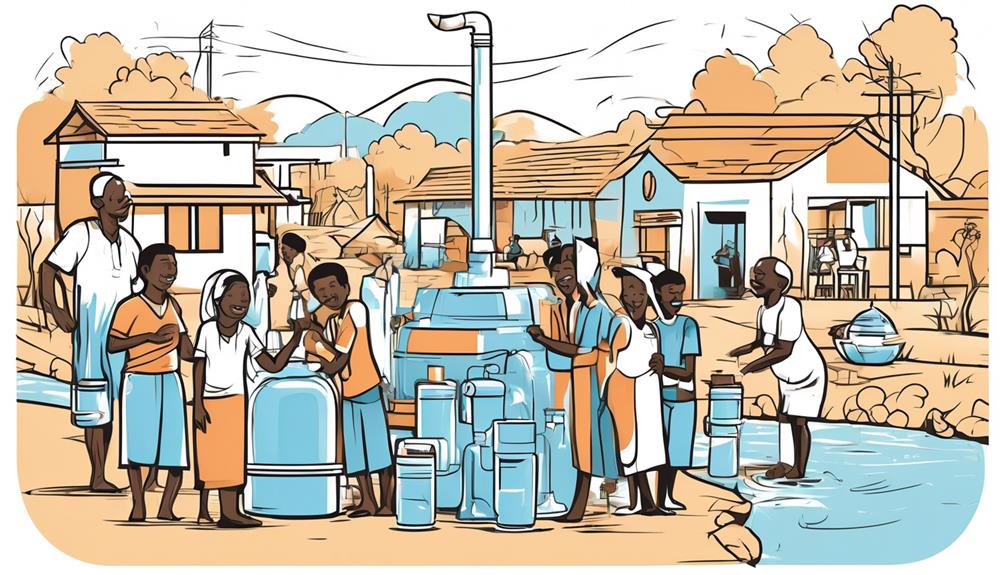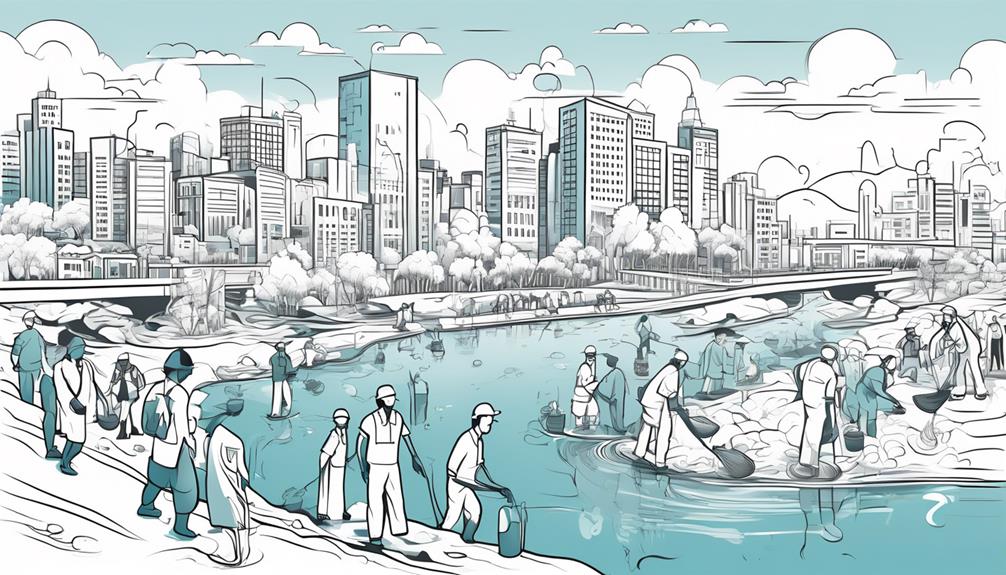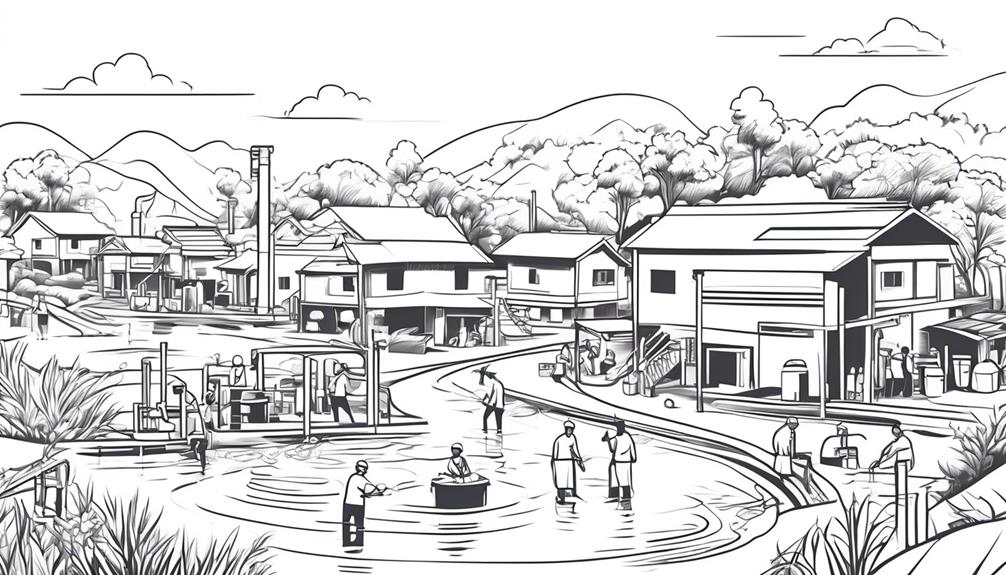Imagine a world where the life-giving force of water, once pure and invigorating, becomes a silent and invisible enemy. In many developing nations, this is the harsh reality faced by communities struggling with water contamination.
But fear not, for there is hope. By understanding the causes and consequences of water contamination, exploring the efforts already underway, and examining the role of governments and NGOs in finding solutions, we can uncover the path towards clean and safe water for all.
So, let us embark on this journey together, where knowledge will be our guide, and the pursuit of a healthier future our destination.
Key Takeaways
- Water contamination in developing nations is caused by poor sanitation practices, inadequate infrastructure, release of waste from industries and agriculture, and lack of access to improved water sources.
- Water contamination in these regions leads to serious health risks, including water-borne diseases, and has a significant impact on child mortality.
- Environmental consequences of water contamination include disruption of ecosystems, decreased soil fertility, and contribution to water scarcity.
- Water contamination has economic implications such as increased spending on water programming, reduced crop yields, negative impact on tourism, and hindered economic growth and development.
Causes of Water Contamination
Water contamination is caused by a combination of factors including poor sanitation practices, inadequate infrastructure, and the release of waste from industries and agriculture. In developing nations, these factors contribute to the lack of clean water and poor water quality.
Many communities in these countries lack access to improved water sources and sanitation facilities, leading to the widespread problem of water contamination. Industrial and agricultural activities often release waste into water sources, further polluting them and making the water unsafe for consumption.
This contaminated water can cause a range of health issues, including diarrhea, cholera, and other waterborne diseases. The lack of access to clean water and sanitation also disproportionately affects women, children, and low-income communities, exacerbating existing inequalities and hindering socio-economic development.
To address water contamination in developing nations, it's crucial to invest in sustainable water resource management, improve infrastructure, and promote proper sanitation and hygiene practices. Education campaigns and community engagement are also essential to raise awareness about the importance of clean water and to empower communities to take action to protect their water sources from pollution.
Impact of Water Contamination
Water contamination in developing nations has significant impacts on various aspects.
Firstly, it poses serious health risks, as contaminated drinking water can lead to water-borne diseases such as cholera, dysentery, and diarrhea, causing a high number of illnesses and deaths, particularly among children.
Secondly, water contamination has severe environmental consequences, including the pollution of water sources and ecosystems, which disrupts the balance of aquatic life and harms biodiversity.
Lastly, the economic implications of water contamination are substantial, as it increases healthcare costs, affects productivity, and hampers socio-economic development.
Health Risks Associated
The impact of water contamination on health is significant, with contaminated drinking water contributing to a majority of diseases in developing countries. Water pollution is responsible for almost 80% of diseases in these regions, causing approximately 71% of all illnesses. Poor water and sanitation conditions result in the deaths of around 1.5 million children under the age of five each year, mainly due to diarrhea. The health risks associated with water contamination are further exacerbated by high levels of naturally occurring arsenic and fluoride in water, which can lead to serious health concerns. Gaps in wastewater treatment also contribute to water pollution and the deterioration of water quality, resulting in severe health impacts. It is crucial to prioritize sustainable solutions that ensure clean and safe water access, proper sanitation, and good hygiene practices to combat water contamination in developing nations.
| Health Risks | |
|---|---|
| – Cholera | – Dysentery |
| – Diarrhea | – Arsenicosis |
| – Fluorosis |
Environmental Consequences of
Pollution caused by water contamination has severe environmental consequences that impact ecosystems and human well-being. In developing countries, the lack of access to safe water and poor water resources management contribute to water contamination. This contamination has detrimental effects on the environment.
It disrupts the balance of ecosystems, leading to the decline of aquatic plants and animals. Water contamination also affects the quality of soil, making it less fertile for agriculture. Additionally, it contributes to water scarcity as contaminated water can't be used for irrigation or other purposes.
Moreover, the environmental consequences of water contamination have a direct impact on human well-being. The spread of water-borne diseases due to poor hygiene and the consumption of unsafe drinking water further exacerbate the health risks faced by communities in developing nations.
Therefore, implementing sustainable water management practices is crucial to mitigate the environmental consequences of water contamination and ensure access to safe and clean water for all.
Economic Implications of
With water contamination having severe environmental consequences, it's important to understand the economic implications of such contamination.
In developing nations, the lack of access to improved water sources and poor quality of water has significant economic impacts. Firstly, addressing water scarcity and obtaining clean water becomes a priority, leading to increased spending on water programming and water purification technologies.
Secondly, the economic development of these nations is hindered as productivity losses occur due to water-related health issues. Moreover, healthcare costs rise as individuals suffer from waterborne diseases and illnesses.
Additionally, agricultural output is affected, leading to reduced crop yields and food insecurity.
Lastly, the tourism industry suffers as contaminated water sources deter visitors, impacting local economies.
Therefore, addressing water contamination is crucial for economic growth and development in the developing world.
Health Risks Associated With Contaminated Water
Contaminated water poses significant health risks, leading to water-borne diseases that contribute to the majority of illnesses in developing countries. Lack of access to clean drinking water, along with severe water scarcity, exacerbates the problem. Water-related diseases, such as cholera, dysentery, and diarrhea, are widespread in these regions, causing approximately 1.5 million deaths annually, with the majority being children under five years old.
The quality of water is critical to human health, and improving water sources is crucial for reducing child mortality rates and overall disease burden.
Global water pollution and gaps in wastewater treatment further degrade the quality of water. This not only affects human health but also reduces the available water for consumption, agriculture, and industrial purposes. High levels of naturally occurring contaminants, such as arsenic and fluoride, are additional concerns that can have severe health impacts.
To address these health risks, efforts must focus on improving access to safe drinking water and implementing effective wastewater treatment systems. By investing in clean water infrastructure and promoting proper sanitation practices, the burden of water-borne diseases can be significantly reduced, ultimately improving the health and well-being of communities in developing nations.
Current Efforts to Address Water Contamination

Now let's look at the current efforts being made to address water contamination.
There are existing initiatives worldwide, such as the Sustainable Development Goals, which have specific targets for water.
Additionally, innovative filtration technologies are being developed to improve water quality.
Community education programs are also being implemented to promote awareness and proper water management practices.
These efforts aim to tackle water contamination and ensure access to safe and clean water for all.
Existing Initiatives Worldwide
Existing initiatives worldwide are working towards addressing water contamination through various approaches, including:
- Public-private partnerships
- Community-based organizations
- Innovative solutions
These initiatives aim to ensure access to safe drinking water and improve water sanitation in developing countries.
One such initiative is the UN Sustainable Development Goals (SDGs). The SDGs include water targets across the 17 goals, with Goal 6 focusing on ensuring access to water and sanitation for all.
Canada also supports sustainable water resources management in developing countries. They contribute to health, education, and economic growth outcomes by funding initiatives such as:
- WASH services during the COVID-19 pandemic
- Groundwater resource access
- Improved sexual and reproductive health and rights (SRHR) through access to improved water, sanitation, and hygiene (WASH) facilities.
These efforts are crucial in providing sustainable water management and addressing water contamination for the global population.
Innovative Filtration Technologies
Innovative filtration technologies are being implemented to address water contamination in developing nations. These technologies aim to provide access to safe drinking water and improve sanitation coverage in these areas. Advanced filtration methods, such as membrane separation, biosand filtration, and ceramic filtration, effectively remove pollutants from water, ensuring its safety for household use.
Solar Water Disinfection and chlorination are also utilized to improve water quality, especially in regions with limited access to clean water. Public-private partnerships, investment by large corporations, and community-based organizations play a crucial role in implementing these filtration technologies.
However, education, government policies, and community involvement are equally important for the successful adoption and sustainability of these innovative filtration technologies. With the implementation of these technologies and the support of various stakeholders, water projects in developing nations can greatly improve water supply and sanitation, leading to healthier communities and better hygiene practices.
Community Education Programs
To further address water contamination, community education programs have been implemented to raise awareness about water conservation and sanitation practices in developing nations. These programs play a vital role in promoting access to safe drinking water and adequate sanitation.
Here are some key points about community education programs:
- Understanding cultural, social, and behavioral factors that influence water use and management is crucial in these programs.
- Collaborative efforts between governments, NGOs, and local communities are essential for sustainable water resource management.
- Education and awareness campaigns empower locals in water management decisions and support community-led initiatives.
These programs aim to address disparities in access to water and sanitation, especially in developing countries. The United Nations and the World Health Organization recognize the importance of community education programs in achieving sustainable water management.
For example, in Sierra Leone, community education programs have been successful in raising awareness and improving water resources management in rural areas.
Role of Government and NGOs in Water Contamination Solutions

Governments and NGOs play a crucial role in addressing water contamination in developing nations. They collaborate with local communities to develop and implement solutions to the water contamination problem.
Governments have a responsibility to create and enforce public policies that prioritize access to safe water for all citizens. They can invest in infrastructure development, such as building water treatment plants and improving sanitation systems. Governments can also establish regulatory frameworks to monitor water quality and enforce standards.
NGOs, on the other hand, often work on the ground to provide immediate relief and long-term solutions. They support community members in implementing water safety plans, which involve regular testing and treatment of water sources. NGOs also raise awareness about water contamination and educate communities on proper hygiene practices to prevent waterborne diseases.
Collaboration between governments, NGOs, and local communities is essential for sustainable water resource management. By working together, they can address the root causes of water contamination and implement effective solutions.
Access to safe water isn't only crucial for public health, but also for socioeconomic development. Therefore, it's imperative that governments and NGOs continue their efforts to ensure that everyone has access to clean and safe drinking water.
Innovative Technologies for Water Treatment in Developing Nations
One effective approach to addressing water contamination in developing nations is through the use of innovative technologies for water treatment. These technologies are playing a crucial role in improving access to safe water and sanitation in developing countries.
Here are three innovative technologies that are being used for water treatment in these nations:
- Membrane separation: This technology uses a thin membrane to remove contaminants from water, ensuring that it's safe for consumption.
- Solar water disinfection: By exposing water to sunlight, this technology kills harmful bacteria and viruses, making it safe to drink.
- Biosand filtration: This simple yet effective technology uses layers of sand and gravel to remove impurities from water, providing clean and safe drinking water.
These innovative technologies are helping to overcome the challenges faced by developing countries in ensuring access to safe water. They offer cost-effective and sustainable solutions for treating water and making it safe for use.
Steps to Promote Clean and Safe Water in Developing Nations

In order to promote clean and safe water in developing nations, it's essential to implement specific steps that address the challenges of water contamination and scarcity.
Access to safe drinking water is crucial for the well-being and development of communities in these nations.
One important step is to invest in water management infrastructure to ensure reliable access to clean water and sanitation. This can include building water treatment plants, improving water distribution systems, and implementing proper waste disposal mechanisms.
Collaborating with governments, NGOs, and local communities is also vital in addressing water scarcity effectively. By working together, we can develop sustainable strategies and policies to protect water resources and ensure efficient water usage.
Promoting education and awareness campaigns is another important step. By educating people about the importance of water conservation and efficient water use practices, we can encourage responsible water consumption.
Additionally, enforcing government policies and regulations to protect water sources and prevent pollution is crucial in combating water contamination.
Frequently Asked Questions
How Can We Help Developing Countries Get Clean Water?
You can help developing countries get clean water by supporting innovative technologies, sustainable solutions, and community involvement. Government initiatives and collaborative partnerships can address funding challenges. Education and awareness, infrastructure development, water purification methods, and capacity building are crucial.
Why Is Water Management so Difficult in Underdeveloped Countries?
Water management is difficult in underdeveloped countries due to infrastructure challenges, lack of funding, limited access to clean water, waterborne diseases, political instability, cultural beliefs, environmental pollution, climate change impact, lack of education and awareness, and the need for sustainable solutions.
How to Treat Drinking Water in Developing Countries?
In developing countries, you can treat drinking water affordably. Get the local community involved, use innovative filtration methods, provide training programs, and receive government support. Create sustainable water treatment with accessible infrastructure. Educate about waterborne diseases and collaborate internationally.
What Is the Biggest Source of Water Contamination in Developing Countries?
The biggest source of water contamination in developing countries is industrial pollution. Harmful chemicals and waste from industries contaminate water sources, leading to waterborne diseases and health risks for communities with limited access to clean water.
Conclusion
Congratulations! You have successfully navigated the waters of this article on addressing water contamination in developing nations.
By shedding light on the causes, impacts, and health risks associated with contaminated water, as well as current efforts and innovative technologies, we hope to have inspired you to take action.
Remember, clean and safe water isn't just a drop in the ocean, but a life-saving elixir that can transform communities and improve public health.
Together, let's make waves of change!
